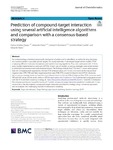Mostrar o rexistro simple do ítem
Prediction of compound-target interaction using several artificial intelligence algorithms and comparison with a consensus-based strategy
| dc.contributor.author | Jimenes-Vargas, Karina | |
| dc.contributor.author | Pazos, A. | |
| dc.contributor.author | Munteanu, Cristian-Robert | |
| dc.contributor.author | Pérez-Castillo, Yunierkis | |
| dc.contributor.author | Tejera, Eduardo | |
| dc.date.accessioned | 2024-04-22T11:03:22Z | |
| dc.date.available | 2024-04-22T11:03:22Z | |
| dc.date.issued | 2024-03-07 | |
| dc.identifier.citation | Jimenes-Vargas, K., Pazos, A., Munteanu, C.R. et al. Prediction of compound-target interaction using several artificial intelligence algorithms and comparison with a consensus-based strategy. J Cheminform 16, 27 (2024). https://doi.org/10.1186/s13321-024-00816-1 | es_ES |
| dc.identifier.issn | 1758-2946 | |
| dc.identifier.uri | http://hdl.handle.net/2183/36289 | |
| dc.description | This work was funded by Universidad de Las Américas and Universidade da Coruña. | es_ES |
| dc.description.abstract | [Absctract]: For understanding a chemical compound’s mechanism of action and its side effects, as well as for drug discovery, it is crucial to predict its possible protein targets. This study examines 15 developed target-centric models (TCM) employing different molecular descriptions and machine learning algorithms. They were contrasted with 17 third-party models implemented as web tools (WTCM). In both sets of models, consensus strategies were implemented as potential improvement over individual predictions. The findings indicate that TCM reach f1-score values greater than 0.8. Comparing both approaches, the best TCM achieves values of 0.75, 0.61, 0.25 and 0.38 for true positive/negative rates (TPR, TNR) and false negative/positive rates (FNR, FPR); outperforming the best WTCM. Moreover, the consensus strategy proves to have the most relevant results in the top of target profiles. TCM consensus reach TPR and FNR values of 0.98 and 0; while on WTCM reach values of 0.75 and 0.24. The implemented computational tool with the TCM and their consensus strategy at: https://bioquimio.udla.edu.ec/tidentification01/. Scientific Contribution: We compare and discuss the performances of 17 public compound-target interaction prediction models and 15 new constructions. We also explore a compound-target interaction prioritization strategy using a consensus approach, and we analyzed the challenging involved in interactions modeling. | es_ES |
| dc.description.sponsorship | Xunta de Galicia; ED431C 2022/46 | es_ES |
| dc.description.sponsorship | This work was supported by the Universidad de las Américas (Ecuador) and by the project Aid for the Consolidation and Structuring of Competitive Research Units (ED431C 2022/46), GRC funded by Xunta de Galicia endowed with EU FEDER funds. The CITIC is funded by the Xunta de Galicia through the collaboration agreement between the Consellería de Cultura, Educación, Formación Profesional e Universidades, and the Galician universities for the strengthening of research centers in the Galician University System (CIGUS). The authors wish to thank the Department of Chemistry and Biochemistry from Universität Bern for starting another alternate server to allow us working with their target fishing algorithms. | es_ES |
| dc.language.iso | eng | es_ES |
| dc.publisher | BMC | es_ES |
| dc.relation.uri | https://doi.org/10.1186/s13321-024-00816-1 | es_ES |
| dc.rights | Atribución 3.0 España | es_ES |
| dc.rights.uri | http://creativecommons.org/licenses/by/3.0/es/ | * |
| dc.subject | Target identification | es_ES |
| dc.subject | Target fishing | es_ES |
| dc.subject | Ligan-based modeling | es_ES |
| dc.subject | Machine learning | es_ES |
| dc.subject | QSAR | es_ES |
| dc.title | Prediction of compound-target interaction using several artificial intelligence algorithms and comparison with a consensus-based strategy | es_ES |
| dc.type | info:eu-repo/semantics/article | es_ES |
| dc.rights.access | info:eu-repo/semantics/openAccess | es_ES |
| UDC.journalTitle | Journal of Cheminformatics | es_ES |
| UDC.volume | 16 | es_ES |
| UDC.startPage | 27 | es_ES |
Ficheiros no ítem
Este ítem aparece na(s) seguinte(s) colección(s)
-
GI-RNASA - Artigos [179]






